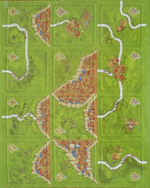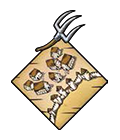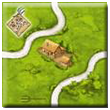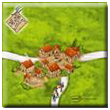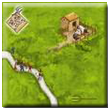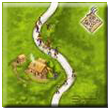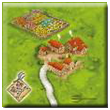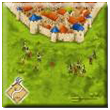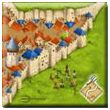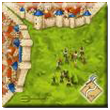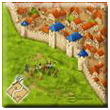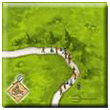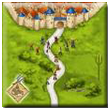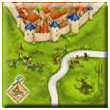De Boerenopstand
Algemene informatie en opmerkingen
De Boerenopstand werd in Template:Year nl uitgegeven door Hans im Glück.
Deze uitbreiding is ontworpen voor het basisspel van Carcassonne. Alle standaard spelregels zijn van kracht, aangevuld met de spelregels voor deze uitbreiding. Je kunt deze uitbreiding – op eigen risico – ook met andere uitbreidingen combineren, er zijn namelijk geen officiële regels voor die combinaties.
Speelmateriaal
- 12 nieuwe landtegels voor boerenopstanden met symbolen voor de verschillende functies.
Spelregels
Voorbereiding
Schud de 12 landtegels van deze mini-uitbreiding. Leg er 3 (zonder te kijken) terug in de doos. Die tegels worden verder niet meer in het spel gebruikt. Schud de overige 9 tegels door de overige landtegels.
Spelverloop
1. Landtegel leggen
De boerenopstand
Zodra er een boerenopstand-tegel getrokken wordt, vindt er een opstand plaats. Leg de tegel voor je neer. [1] Kijk nu of één of meer van jouw meeples op het type project staan dat in het ruitvormige symbool op de tegel staat (stad, weg of klooster), en of die meeples "onbeschermd" of "beschermd" zijn.
|
|
Al je onbeschermde meeples op de betreffende projecten, moeten onmiddellijk terug naar je voorraad. | |
|
|
Voor elke beschermde meeple op de betreffende projecten krijg je 2 punten. Beschermde meepls blijven na de opstand beschermd. | |
|
(Hoe je je meeples kunt beschermen wordt uitgelegd bij 2. Een meeple zetten.) |
||
Opmerking: Als je tenminste één meeple terug moest nemen, is de opstand voorbij en ga je op de normale manier verder met je beurt.
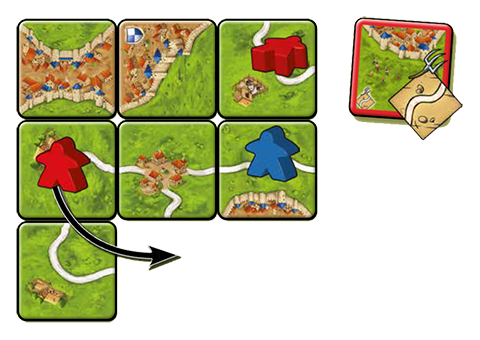
De onbeschermde meeple van Rood staat op de weg links. Deze meeple gaat terug in voorraad. De beschermde meeple van Rood rechts blijft op de tegel en levert 2 punten op.
De opstand is voorbij. De blauwe meeple wordt niet getroffen. Leg nu de landtegel volgens de gebruikelijke regels aan en ga door met je beurt.
De boerenopstand gaat verder bij de volgende speler
Als je geen meeple terug in voorraad hoeft te nemen omdat geen van jouw meeples op getroffen projecten staan of omdat al jouw meeples op de getroffen projecten beschermd zijn, gaat de boerenopstand verder bij de volgende speler. Deze kijkt op de eerder beschreven manier ook of zij of hij door de opstand getroffen wordt en of ze punten krijgen voor beschermde meeples. Als ook deze speler niet door de boerenopstand wordt getroffen gaat deze door naar de volgende speler.
This continues until a player has to return at least 1 meeple to their supply, or none of the players have been affected. Now, place the land tile according to the usual rules and continue your turn.
Note! Only players, who have to check their meeples during the peasant revolt, score points for their protected meeples. Players who are not hit by the peasant revolt cannot score any points for protected meeples.

The peasant revolt moves on to Blue. Blue is sitting to your left, and continues to check, if and how the peasant revolt affects them. Blue has 1 protected meeple in the city on the left, which scores 2 points. The unprotected meeples have to be returned into Blue’s supply. That is how the revolt ends and you place the land tile according to the usual rules and continue your turn.
2. Placing a meeple
Protecting a meeple from a peasant revolt
If you place a meeple on the tile just placed, you may also protect this very meeple, for the cost of 4 points. To do so, move your meeple on the score board back by 4 spaces. It is possible to score negative points. Next, “lay down” this meeple. This meeple has now joined the farmers. [2]
Each time you do not place a meeple on the tile you just have placed, [3] you may protect one of your meeples standing on tiles for the cost of 2 points.
Farmers cannot be protected. They are never affected by peasant revolts.
A meeple “lying down” is protected from a peasant revolt. In case the revolt affects you, you score 2 points for each protected meeple in an affected feature (see 1. Placing a tile).
3. Scoring a feature
When scoring a feature, a protected meeple is treated like a normal meeple. It is returned into your supply after the feature has been scored. After that, it loses its protection from peasant revolts. This means, that if you place that meeple again, it is unprotected once again.
Final scoring
Final scoring is performed according to use usual rules. When scoring a feature, a protected meeple is treated like a normal meeple.
Tile distribution
Total Tiles: 12
Several tiles have a small illustration on them. The letters in brackets show which illustration is on each tile:
Footnotes
For Icons explanation and licensing please visit Icons page.
- ↑
 De acties die aan de boerenopstand verbonden zijn worden altijd uitgevoerd, ook als de tegel daarna niet aangelegd kan worden. De spelregels bevatten geen beperkingen zou deze situatie zich voordoen. In dat geval worden de acties uitgevoerd, de tegel weggelegd en trekt de speler een nieuwe tegel. In dat geval kan de speler in dezelfde beurt meerdere opstanden veroorzaken.
De acties die aan de boerenopstand verbonden zijn worden altijd uitgevoerd, ook als de tegel daarna niet aangelegd kan worden. De spelregels bevatten geen beperkingen zou deze situatie zich voordoen. In dat geval worden de acties uitgevoerd, de tegel weggelegd en trekt de speler een nieuwe tegel. In dat geval kan de speler in dezelfde beurt meerdere opstanden veroorzaken.
- ↑
 This sentence, misplaced in the ZMG rules, may be misleading and it has no effect in gameplay. It just stresses that your meeple has become a supporter of the peasants' cause. This would simply justify that it will not be affected by any possible revolts.
This sentence, misplaced in the ZMG rules, may be misleading and it has no effect in gameplay. It just stresses that your meeple has become a supporter of the peasants' cause. This would simply justify that it will not be affected by any possible revolts.
- ↑
 This wording is based on the German rules. The English rules read "Each time you choose not to place a meeple on the tile you just have placed" and it can be somewhat misleading. You may interpret that you need at least one meeple in your supply in order to be able to choose not to place it.
This wording is based on the German rules. The English rules read "Each time you choose not to place a meeple on the tile you just have placed" and it can be somewhat misleading. You may interpret that you need at least one meeple in your supply in order to be able to choose not to place it.
The German rules allow you not to place a meeple just simply because you don't have any left in your supply. In this case, there is no decision involved; it is your only option.
- Editor Manual - Old numbered parameters - RulesPlacingTile
- Editor Manual - Old numbered parameters - RulesPlacingMeeple
- Editor Manual - Old numbered parameters - RulesScoring
- Editor Manual - Old numbered parameters - Tile
- Under Construction
- Second Edition
- Second Edition Minor Expansion
- Old template
- Old template - FootnoteIconPara en

